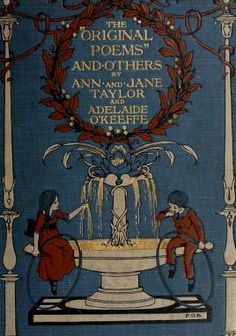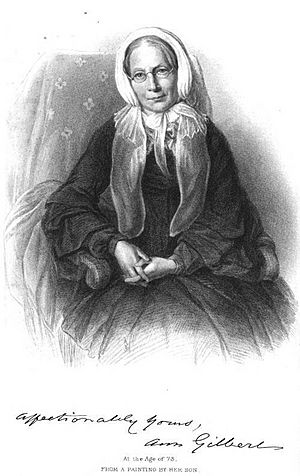Ann Taylor (poet) facts for kids
Ann Taylor (born January 30, 1782 – died December 20, 1866) was an English poet and writer. She became very popular when she was young for writing poems for children. She is best known as the older sister and writing partner of Jane Taylor.
Family Life
Ann and Jane Taylor came from a family of writers. Their parents were Isaac Taylor, an engraver and teacher, and Ann Taylor, a writer. Ann was born in Islington. She lived with her family in different places like London, Lavenham, Suffolk, Colchester, and Ongar.
Their father, Isaac Taylor, later became a minister and wrote many educational books for young people. Their mother, Ann Martin Taylor, wrote books with moral and religious advice.
Ann and Jane had several brothers who were also involved in writing and publishing. Their brother Isaac wrote about religion and invented a beer tap. Their elder brother Charles Taylor edited a magazine and translated a large Bible dictionary. Their youngest brother Josiah was a publisher, mainly for books on architecture.
Her Writings

People often get the works of Ann and Jane Taylor mixed up, usually giving Jane more credit. This happened because their early children's books were published together without saying who wrote which poem. Also, Jane died young, which led to many tributes about her work. Because of this, many of Ann's poems were mistakenly thought to be Jane's.
While Jane wrote more poetry for adults, Ann also wrote important poems. Her poem "The Maniac's Song" was very strong.
Ann Taylor also wrote excellent prose, especially her autobiography and many letters. Her writing style was clear and lively. She often wrote about moral and religious topics, but also showed a good sense of humor. Her autobiography gives a detailed look into the life of a well-off family in the late 1700s and early 1800s.
Famous Poems
Ann Taylor's son, Josiah Gilbert, once said:
-
- "Two little poems – 'My Mother', and 'The Star', are perhaps, more frequently quoted than any. The first, a lyric of life, was by Ann, the second, of nature, by Jane; and they illustrate this difference between the sisters."
Both poems were so popular that many people made fun versions of them in the 1800s.
The book Original Poems for Infant Minds by several young persons was first published in 1804. It was very successful, so a second book came out in 1805. Adelaide O'Keeffe wrote over 30 poems in this collection, though she is not always given full credit.
Ann Taylor's poem "My Mother" became a favorite. It was printed many times throughout the 1800s and was still memorized by children in the mid-1900s. Early versions of "My Mother" had illustrations by Peltro Williams Tomkins. Later illustrators, like Walter Crane, showed new ideas about motherhood and different art styles.
Another important poem by Ann from Original Poems for Infant Minds is "The Sign-Post." This poem tells a scary story about a boy who is afraid of a ghostly sign-post. But it ends with lessons about checking for facts instead of giving in to silly fears.
Ann and Jane Taylor also wrote Rhymes for the Nursery (1806) and Hymns for Infant Minds (1808). In Original Poems, the authors were named for each poem. But in Rhymes for the Nursery, they were not. A book called The Taylors of Ongar: An Analytical Bio-Bibliography by Christina Duff Stewart helps us know who wrote which poem.
Marriage and Later Life
On December 24, 1813, Ann married Joseph Gilbert. He was a minister and writer. Ann moved far from her family to Masborough near Rotherham. Joseph Gilbert had proposed to Ann before they even met, after reading her writings and seeing her intelligence.
At the time of their marriage, Gilbert taught at Rotherham Independent College. This was a special school for people who were not part of the main Church of England. He was also a pastor in Sheffield. Later, he moved to Hull in 1817, and then to Nottingham in 1825, where he stayed for the rest of his life.
Even though she was busy as a wife and mother, Ann Gilbert continued to write poems, hymns, essays, and letters. She cared about public issues like fighting against slavery and improving prisons. She even wrote about these topics. Interestingly, for someone with strong and often liberal views, she was against women getting the right to vote.
After her husband died on December 12, 1852, Ann wrote a book about his life. She did not stop being active in her old age. She supported her large family by visiting them and writing many letters. She also traveled a lot around Britain, even though travel was difficult back then. Ann Taylor died on December 20, 1866. She was buried next to her husband in Nottingham General Cemetery.
See Also
- Ann Taylor, The Autobiography and Other Memorials of Mrs Gilbert, Formerly Ann Taylor, ed. Josiah Gilbert. London: Henry S. King & Co., 1874
- Memoirs, Correspondence and Poetical Remains of Jane Taylor Volume I of The Writings of Jane Taylor, In Five Volumes: Boston: Perkins & Marvin, 1832
- Juvenile Literature by Ann Taylor at University of Florida, Baldwin Library of Historical Children's Literature


